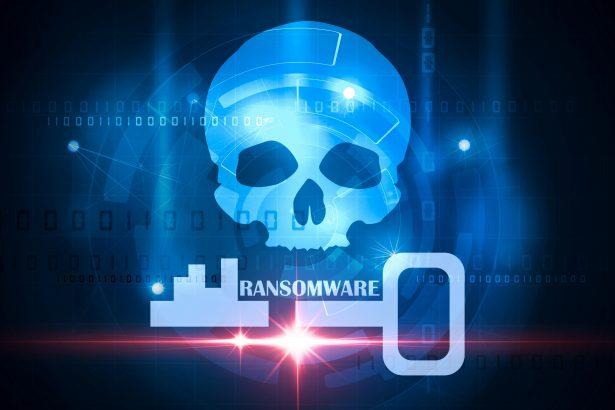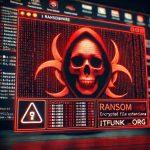What is SKUNK Ransomware?
SKUNK is a ransomware-type malware designed to encrypt files on infected systems, rendering them inaccessible. Once it strikes, the malware appends the “.SKUNK” extension to the encrypted files, and the victim is left with a ransom note detailing instructions that, curiously, relate to hacktivism rather than a direct ransom request. This odd motivation behind SKUNK ransomware makes it stand out in comparison to typical ransomware attacks.
Unlike many ransomware variants that demand payment in exchange for a decryption key, SKUNK claims that it was created as a protest against malware prosecution laws. The attacker claims to be lobbying for the release of a hacker arrested for creating a DOS virus 20 years ago. Despite the strange reasoning behind the attack, the malware still follows the typical encryption and ransom model, although the ransom message does not ask for direct payment.
Ransomware Messages and Behavior
Upon infection, SKUNK changes the victim’s desktop wallpaper, showing a message protesting the prosecution of M.Z. Skuanks, who is supposedly the hacker behind the malware. The pop-up and text file provide the victim with instructions, urging them to lobby or protest against malware prosecution laws to receive the decryption key. The ransomware even includes warnings that entering the wrong key will result in corrupted files, adding a sense of urgency to the situation.
Wallpaper Message:
“YOUR COMPUTER HAS BEEN SKUNKED UP BY SKUNKSOMWARE. To get your files back, you must lobby your local government agencies to loosen up malware laws. M.Z. Skuanks was arrested for a DOS virus he made 20 years ago, before malware laws were as they are now. He does not deserve this punishment. Lobby or protest, and we will restore your files. #FreeMZSkuanks”
Pop-Up Message:
“SKUNKSOMWARE – DECRYPTOR
If you provide the wrong key your files are f**ked.
All of your files have been skunked up with military grade encryption. To decrypt your files, you must lobby or protest against malware prosecution. M.Z. Skuanks was arrested for a MS DOS virus he made 20 years ago, before malware laws were what they are now. This is unjust, and Skuanks should not have been prosecuted. To decrypt your files, upload proof of you lobbying or protesting, and we will reach out to you and give you a key to decrypt your files.”
Text File (“READ_THIS.TXT”):
“Oops! Your files have been encrypted with military grade encryption by skunksomware!
< How do I get my files back? >
To decrypt your files, you must lobby or protest against malware prosecution. M.Z. Skuanks was arrested for a MS DOS virus he made 20 years ago, before malware laws were what they are now. This is unjust, and Skuanks should not have been prosecuted. To decrypt your files, upload proof of you lobbying or protesting, and we will reach out to you and give you a key to decrypt your files.”
SKUNK Ransomware Summary Table
| Feature | Details |
|---|---|
| Threat Type | Ransomware, Crypto Virus, File Locker |
| Encrypted File Extension | .SKUNK |
| Ransom Note File Name | READ_THIS.TXT |
| Associated Email Addresses | None provided |
| Detection Names | Avast (Win32:Evo-gen [Trj]), Combo Cleaner (Gen:Variant.Lazy.453332), ESET-NOD32 (A Variant Of Generik.LCCCLRQ), Kaspersky (Trojan-PSW.Win32.Stealer.cocs), Microsoft (Trojan:Win32/Wacatac.B!ml) |
| Symptoms of Infection | Files cannot be opened, extension changed to .SKUNK, desktop wallpaper and pop-up messages shown |
| Damage | Encryption of all files, system performance degradation, potential installation of other malware (password stealers, trojans) |
| Distribution Methods | Phishing emails, torrent websites, malicious ads |
| Danger Level | High – potential for data loss and further malware infections |
Ransomware Behavior and Effects
When SKUNK infects a computer, it encrypts files and appends the “.SKUNK” extension to them, preventing the victim from accessing their data. While it displays a series of messages regarding protest and lobbying, the overall impact is the same as any other ransomware attack: loss of access to valuable files. SKUNK also contains a spreading mechanism, allowing it to propagate through local area networks (LAN) by exploiting vulnerabilities in connected devices.
The malicious pop-ups and text files explain that victims need to take action by protesting or lobbying, but these messages are mostly aimed at creating confusion and amplifying the hacker’s cause rather than demanding a financial ransom. Despite the odd justification for the attack, victims are still left with encrypted files and no clear way to recover them unless a decryption key is provided.
Manual Ransomware Removal Guide
Warning: Manual removal is complex and risky. If not done correctly, it can lead to data loss or incomplete removal of ransomware. Only follow this method if you are an advanced user. If unsure, proceed with Method 2 (SpyHunter Removal Guide).
Step 1: Disconnect from the Internet
- Unplug your Ethernet cable or disconnect Wi-Fi immediately to prevent further communication with the ransomware’s command and control (C2) servers.
Step 2: Boot into Safe Mode
For Windows Users:
- For Windows 10, 11:
- Press Windows + R, type
msconfig, and hit Enter. - Go to the Boot tab.
- Check Safe boot and select Network.
- Click Apply and OK, then restart your PC.
- Press Windows + R, type
- For Windows 7, 8:
- Restart your PC and press F8 repeatedly before Windows loads.
- Select Safe Mode with Networking and press Enter.
For Mac Users:
- Restart your Mac and immediately press and hold the Shift key.
- Release the key once you see the Apple logo.
- Your Mac will start in Safe Mode.
Step 3: Locate and Terminate Malicious Processes
For Windows Users:
- Press Ctrl + Shift + Esc to open Task Manager.
- Look for suspicious processes (e.g., unknown names, high CPU usage, or random letters).
- Right-click on the process and select End Task.
For Mac Users:
- Open Activity Monitor (Finder > Applications > Utilities > Activity Monitor).
- Look for unusual processes.
- Select the process and click Force Quit.
Step 4: Delete Malicious Files
For Windows Users:
- Press Windows + R, type
%temp%, and hit Enter. - Delete all files in the Temp folder.
- Navigate to:
C:\Users\[Your Username]\AppData\RoamingC:\Users\[Your Username]\AppData\LocalC:\Windows\System32
- Look for suspicious files related to the ransomware (random file names, recently modified) and delete them.
For Mac Users:
- Open Finder and go to Go > Go to Folder.
- Type
~/Library/Application Supportand delete suspicious folders. - Navigate to
~/Library/LaunchAgentsand remove unknown.plistfiles.
Step 5: Remove Ransomware from Registry or System Settings
For Windows Users:
Warning: Incorrect changes in the Registry Editor can damage your system. Proceed with caution.
- Press Windows + R, type
regedit, and hit Enter. - Navigate to:
HKEY_CURRENT_USER\SoftwareHKEY_LOCAL_MACHINE\Software
- Look for unfamiliar folders with random characters or ransomware-related names.
- Right-click and select Delete.
For Mac Users:
- Go to System Preferences > Users & Groups.
- Click on Login Items and remove any suspicious startup items.
- Navigate to
~/Library/Preferencesand remove malicious.plistfiles.
Step 6: Restore System Using System Restore (Windows) or Time Machine (Mac)
For Windows Users:
- Press Windows + R, type
rstrui, and hit Enter. - Click Next, choose a restore point before the infection, and follow the prompts to restore your system.
For Mac Users:
- Restart your Mac and hold Command + R to enter macOS Utilities.
- Select Restore from Time Machine Backup.
- Choose a backup prior to the ransomware infection and restore your system.
Step 7: Use a Decryption Tool (If Available)
- Visit No More Ransom (www.nomoreransom.org) and check if a decryption tool is available for your ransomware variant.
Step 8: Recover Files Using Backup
- If you have backups on an external drive or cloud storage, restore your files.
Automatic Ransomware Removal Using SpyHunter
If manual removal seems too risky or complicated, using a reliable anti-malware tool like SpyHunter is the best alternative.
Step 1: Download SpyHunter
Download SpyHunter from the official link: Download SpyHunter
Or follow the official installation instructions here:
SpyHunter Download Instructions
Step 2: Install SpyHunter
- Open the downloaded file (
SpyHunter-Installer.exe). - Follow the on-screen prompts to install the program.
- Once installed, launch SpyHunter.
Step 3: Perform a Full System Scan
- Click on Start Scan Now.
- SpyHunter will scan for ransomware and other malware.
- Wait for the scan to complete.
Step 4: Remove Detected Threats
- After the scan, SpyHunter will list all detected threats.
- Click Fix Threats to remove the ransomware.
Step 5: Use SpyHunter’s Malware HelpDesk (If Needed)
If you are dealing with a stubborn ransomware variant, SpyHunter’s Malware HelpDesk provides custom fixes to remove advanced threats.
Step 6: Restore Your Files
If your files are encrypted:
- Try No More Ransom (www.nomoreransom.org) for decryption tools.
- Restore from cloud storage or external backups.
Preventing Future Ransomware Attacks
- Keep backups on an external hard drive or cloud storage.
- Use SpyHunter to detect threats before they infect your system.
- Enable Windows Defender or a trusted antivirus program.
- Avoid suspicious emails, attachments, and links.
- Update Windows, macOS & software regularly.
Conclusion
SKUNK ransomware represents an unusual and unsettling form of cyberattack, using encryption and protest as a mechanism for spreading its message. While the ransomware claims to have political motivations, the damage caused is consistent with that of typical ransomware attacks. The files are locked and the only way to recover them is through a backup or by obtaining the decryption key, which is highly unlikely without following the strange instructions provided by the attacker.




